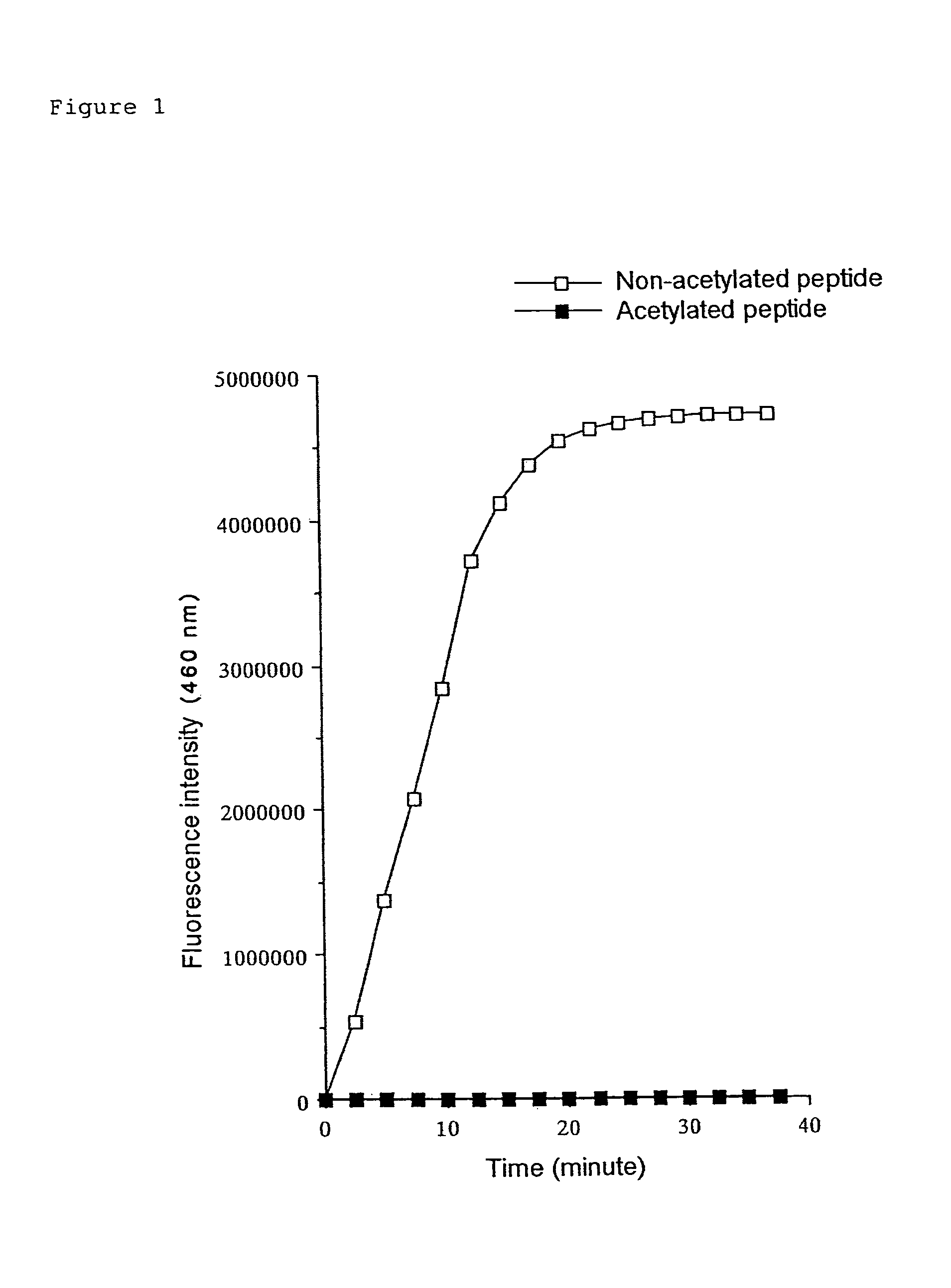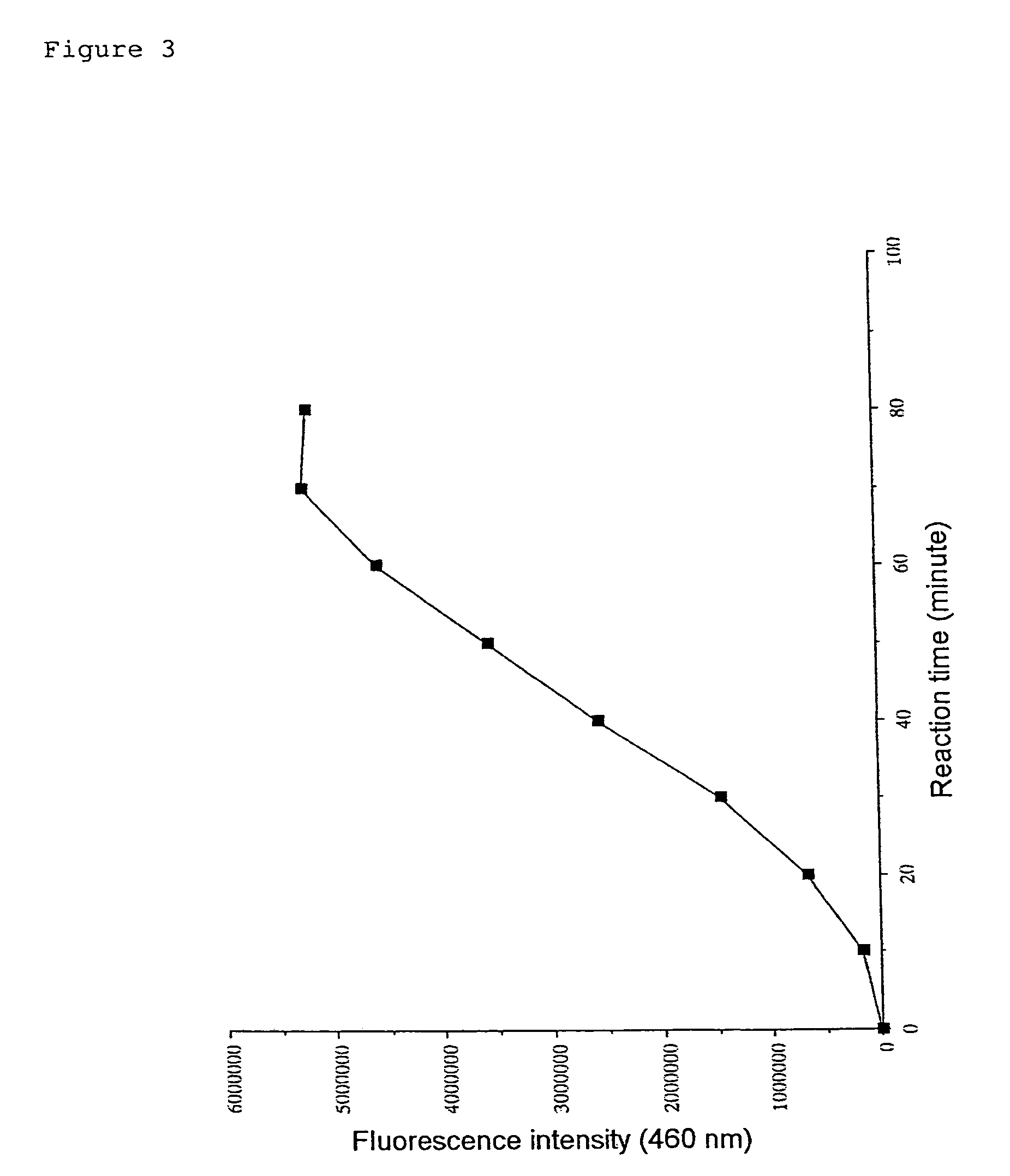Kit for determining the acetylation level of a peptide based on sensitivity of the peptide to peptidase
a technology of acetylation level and kit, which is applied in the field of kit for determining the acetylation level of a peptide, can solve the problems of difficult treatment of multiple samples and carrying out various conditions, and the complexity of most conventional methods, and achieves the effect of reducing the complexity of conventional methods, and reducing the difficulty of acetylation
- Summary
- Abstract
- Description
- Claims
- Application Information
AI Technical Summary
Benefits of technology
Problems solved by technology
Method used
Image
Examples
example 1
Preparation and Purification of Recombinant Histone Deacetylase by Gene Recombination
(1) Isolation of the Histone Deacetylase Gene by RT-PCR
[0129]Today, three types of histone deacetylase genes have been reported: HDAC1 / RPD3 (Taunton, J. et al., Science Vol. 272, 408-411, 1996; Rundlett, S. E. et al., Proc. Natl. Acad. Sci. USA. Vol. 93, 14503-14508); HDAC2 / YY-1BP (Yang, W. M. et al., Proc. Natl. Acad. Sci. USA. Vol. 93, 12845-12850; Lusser, A. et al., Science Vol. 277, 88-91, 1997); and HDAC3 (Yang, W. M. et al., J. Biol. Chem. Vol. 272, 28001-28007). HDAC1 / RPD3 (Genbank Accession#: U0079) and HDAC3 (Genbank Accession#: U66914) among them were amplified and isolated by RT-PCR. Primers comprising the following nucleotide sequences were used for the PCR.
(a) Primers
[0130]
Forward primer (HD1F):5′-CGCGGATCCATGGCGCAGACGCAGGGCACC-3′(SEQ ID NO:3)
[0131](The three nucleotides, “CGC”, at the 5′ end were added to facilitate restriction enzyme reaction. The segment, “GGATCC”, from the 4th nucle...
example 2
Partial Purification of Histone Deacetylase from Human Culture Cell Line
[0171]MCF7 cells were washed with PBS, and then centrifuged. Precipitated cells were suspended in 4 ml lysis buffer and were left standing 15 minutes on ice. 5 ml lysate buffer was obtained by washing the centrifuge tube with 1 ml lysis buffer. The lysate was loaded on 15 ml sucrose cushion buffer in a centrifuge tube for type-07 rotor. Then, The tubes were centrifuged at 1300 g for 20 minutes and precipitated cells were recovered with 1.5 ml of the lysis buffer. After washing the cells, the cells were suspended in 700 μl low-salt buffer. The cells were sonicated for 30 seconds, and then allowed to stand still on ice for 30 minutes. The lysate was centrifuged at 100,000 g for 40 minutes, and the supernatant was collected to recover crude histone deacetylase. The pooled crude histone deacetylase was placed in a 1.5-ml tube, and was dialyzed overnight against a solution containing 50% glycerol, 150 mM NaCl, and 20...
example 3
Measurement of the Deacetylase Activity
(1) Substrate Peptide
Boc-Val-Leu-(Ac)Lys-MCA
[0184]The substrate peptide was prepared by condensing the amino group of the fluorescent substance AMC (7-amino-4-methyl-coumarin) and the carboxyl group of a peptide comprising a lysine with acetylated ε-amino group. The peptide was prepared by custom synthesis by PEPTIDE INSTITUTE, INC.
(2) Measurement Procedure
[0185]1 μl of DMSO solution containing 10 mM substrate peptide, Boc-Val-Leu-(Ac)Lys-MCA, was added to 64 μl HDAC reaction buffer (25 mM Tris-HCl pH 7.5) for each assay. The mixture was poured into the wells of a microplate for fluorometry and was incubated at 30° C. Then, 10 μl of histone deacetylase solution was added to each well and the plate was subjected for deacetylation at 30° C. for 60 minutes. After the reaction, 5 μl of peptidase solution that was diluted with 25 mM Tris-HCl (pH 7.5) to an optimal concentration and 20 μl 5× protease reaction buffer were added to each well. The fluor...
PUM
 Login to View More
Login to View More Abstract
Description
Claims
Application Information
 Login to View More
Login to View More - R&D
- Intellectual Property
- Life Sciences
- Materials
- Tech Scout
- Unparalleled Data Quality
- Higher Quality Content
- 60% Fewer Hallucinations
Browse by: Latest US Patents, China's latest patents, Technical Efficacy Thesaurus, Application Domain, Technology Topic, Popular Technical Reports.
© 2025 PatSnap. All rights reserved.Legal|Privacy policy|Modern Slavery Act Transparency Statement|Sitemap|About US| Contact US: help@patsnap.com



